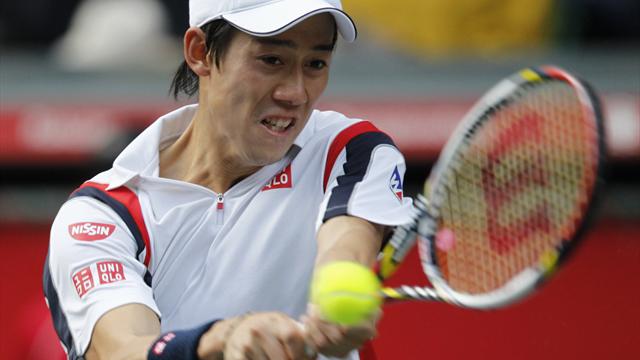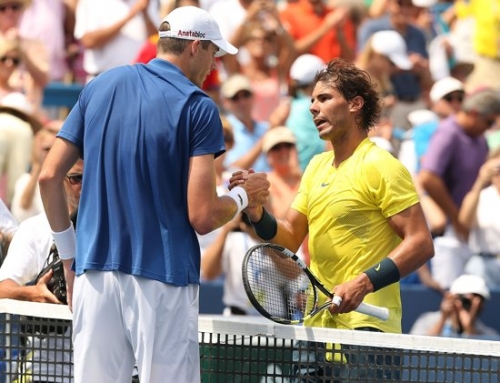 Ever since Murray and Djokovic rose to the top sometime between 2007 and 2008, tennis pundits have wondered who the next generation would bring. When Raonic made a breakthrough at the Australian Open in 2011 reaching the fourth round, then won his first event in San Jose and reached the finals of Memphis, his name was mentioned in the same breath as Ryan Harrison, Bernard Tomic, and Grigor Dimitrov.
Ever since Murray and Djokovic rose to the top sometime between 2007 and 2008, tennis pundits have wondered who the next generation would bring. When Raonic made a breakthrough at the Australian Open in 2011 reaching the fourth round, then won his first event in San Jose and reached the finals of Memphis, his name was mentioned in the same breath as Ryan Harrison, Bernard Tomic, and Grigor Dimitrov.
But it may be that the class of this field is Kei Nishikori and Milos Raonic.
Although Raonic did not win this event, he had two big wins over Tipsarevic and Murray, and it looked, for the first time, that Raonic had been adding enough pieces to his game to make people believe he could, at the very least, reach the top ten. In particular, Raonic has been doing a better job on the return game, looking to attack with huge crosscourt swipes.
If you had seen either player, you knew the basic rhythm of the match. It would pit the big serve and big groundstrokes of Raonic against the speed and angled shotmaking of Kei Nishikori. Back in late 2009, a Russian, one Nikolay Davydenko, found a different way to play the top players. Perhaps as the successor to Agassi, Davydenko played tight into the baseline, and drove angles, forcing players out wide.
Since then, Davydenko’s game has slid and his confidence in hitting these angled shots has similarly fell. But perhaps the mantle has been passed to Nishikori.
Nishikori, like he did with players like Berdych and Baghdatis, wanted to hit to the edges of the court and force his opponent to run hard to get to the ball. While Raonic’s movement has improved quite a bit, he struggled to stay in some of these rallies. Raonic’s general strategy was to hit very hard, angled, and crosscourt. However, Nishikori found ways to take those shots up the line and prevent Raonic from taking advantage of this shot.
The first set was close with both players taking a break. The tiebreak was decided on a late mini-break by Nishikori which he used to take the first set.
However, Raonic appeared to be finding his game, and broke Nishikori in the middle of the second set. Every time Nishikori seemed to have a chance to break, Raonic would deliver a huge serve. Raonic took the second set 63.
This gave no indication what would happen in the third set. Raonic would serve far fewer aces in the third set than the other sets and Nishikori appeared to see the ball somewhat better. He would get an early break over Raonic, but then began to pour it on. Even after his second break which mostly assured a win, he kept fighting in Raonic’s last service game and eventually Raonic netted a shot and gave the final break. For a guy that holds greater than 90% of his serves, it’s pretty impressive for Nishikori to break three times.
Many of Raonic’s patterns that worked well against Murray did not work as well. In particular, Raonic was able to make Murray hit slice backhands as he hit powerful inside out backhands. Nishikori never seemed to get in this pattern. Nishikori was more willing to use angles and switching of lines to keep Raonic off-balance, a strategy that Murray does not find comfortable to employ.
Nishikori becomes the first Japanese player to win this title since the tournament had international players in 1973. They invited Ken Rosewall, who was the first winner back in 1973. The event started in 1972 but was for Japanese players only. One of the more bizarre prizes was a year’s supply of Corona beer, 365 in all. Nishikori said he hasn’t exactly developed a taste for beer, so he’s not sure what to do with that.
Due to the momentous occasion, the finals ceremony has run over half an hour. Both Raonic and Nishikori may soon head up to the top ten.
Next week: Shanghai



![[Basel] del Potro wins Basel over Federer for second consecutive year](https://www.essentialtennis.com/wp-content/uploads/2013/10/20131028delpo-500x383.jpg)


![[Cincinnati] Nadal wins 26th Masters 1000 title with win over Isner 7-6, 7-6](https://www.essentialtennis.com/wp-content/uploads/2013/08/20130818rafa-500x383.jpg)
![[Montreal] Nadal crushes Raonic to win 25th Masters 1000 title](https://www.essentialtennis.com/wp-content/uploads/2013/08/20130811nadal-500x383.jpg)